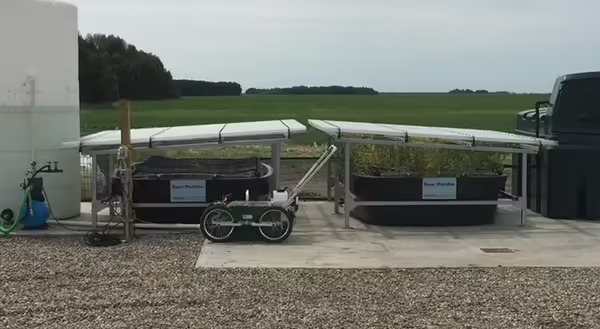
Private applicators have a novel way to handle spray tank residues when cleaning agricultural machinery and spraying equipment that was presented at the 2025 Pesticide Stewardship Alliance annual conference recently. The following information was provided by Lee Huber, SR. Residue Manager with Bayer Crop Science.
“Leftover spray tank residue represents a potential for point source of surface water pollution. Also, spray residues left in the tank and wastewater from the cleaning operation can enter water bodies if not handled properly.” In response to this need, Bayer Crop Science approached this holistically by developing PhytobacTM, an innovative solution to manage spray tank residues.
What is a Phytobac?
A Phytobac is a biological system for the sustainable disposal of crop protection effluent. It was developed by Bayer Crop Science and Beutech Kunststoffen. The idea was derived from the bio-bed concept where millions of micro-organisms work to break down crop protection products. Please note that the Phytobac is restricted to crop protection product rinse waste generated on the farm. This contaminated water is collected on a concrete slab and then directed into the Phytobac buffer tank. A control system then regulates the sprinkling of that water onto the substrate container.
More specifically, the Phytobac is a sealed container filled with a mixture of local soil and chopped straw (3:1). This facilitates the growth of necessary microbial strains to break down active ingredients, provides the required degree of porosity, and serves as a source of energy for the microorganisms. The Phytobac system captures the spray tank solution and pumps it onto the soil/straw mixture under optimum moisture levels for microbial activity. In addition to microbial degradation, phytobac also utilizes evaporation and photolytic activity. A transparent roof cover prevents flooding yet encourages photolytic breakdown while open air promotes evaporation. The container itself is sturdy and impermeable.
There are factors which would affect how much volume a Phytobac can handle. These include: microbial populations, soil type, concentrations of rinse water, air circulation, and temperatures.
Why should a farmer consider using a Phytobac?
Certainly, it provides a single self-contained point for contaminated rinse waste, and it allows users to treat rinse water in a simple, responsible, environmentally friendly manner. This system is to be used when cleaning out spray equipment on the farm and is not to replace field spray outs. Preventing possible contamination of nearby water bodies and soil while cleaning spray equipment is important. Also, Huber called the Phytobac “convenient and easy to build and use”. Various modules, sizes, and models exist for different size operations. For more information about Phytobac, please see their website or email lee.huber@bayer.com.
ABOUT THE AUTHOR: Michelle Wiesbrook provides subject matter expertise and training in pesticide safety with an emphasis on horticultural weed science. She serves as the Illinois Pesticide Review newsletter editor, collecting and organizing material.